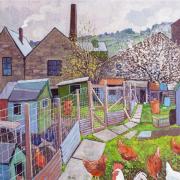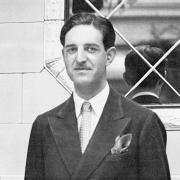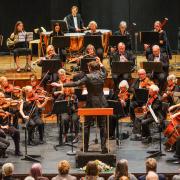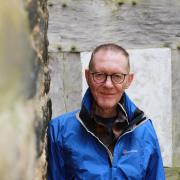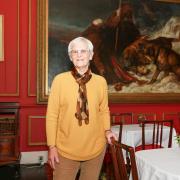Whalley Abbey, one of the most historic sites in Lancashire, faces a fight for its future, as Paul Mackenzie reports Photography by Kirsty Thompson
It has been one of Lancashire’s most important buildings for more than 800 years but Whalley Abbey faces an uncertain future. Efforts will this year be renewed to make the site more of a commercial success but should they fail, Archdeacon John Hawley says the Blackburn Diocese would have to consider selling the site.
‘It’s a tricky one,’ said Archdeacon Hawley. ‘It’s not just a matter of having it as a good wedding or conference venue, we have got to do creative things to bring people through.
‘The people of the diocese have got to make a decision on whether they want the abbey to have a long term future and the Diocese of Blackburn has to decide if they want to put significant money into it to repair and run the abbey. ‘A new bishop will be appointed very soon and the future of the abbey will be a very significant issue they will have to face.
‘By next year maybe we will know if it has a long term future or not.’And Archdeacon Hawley, who has been with the diocese for 11 years since he crossed the Pennines, added: ‘I believe that holy places and sacred places are very important and we should want to keep it, not because of its potential as a hotel or guest house, but because of its special spiritual and historical significance.
‘Since its earliest monastic foundations the abbey was famous for its hospitality and care of people. Hospitality and education were key issues in monastic life, now we need to use the whole site as a place of hospitality and education. We need a vision of how we can do that, particularly when it costs so much money to keep the house open and maintained.
‘The abbey has always been slightly cut off from the community, hidden behind the high walls, but we need to open it up and become more inviting. We are only at the beginning of a new phase in the abbey’s history and I don’t really know where it will lead. Various attempts have been made in the past to open the abbey up and to get it on the tourist trails and I don’t know why it hasn’t happened.’
The abbey site is steeped in history. In 1296 monks made the move north to a site beside the Ribble at Whalley from Stanlow on the south bank of the Mersey and the church was built here between 1330 and 1380. The abbey was completed by the 1480s and Whalley was a large and important Cistercian Monastery, until the Dissolution in 1537 and the execution of last abbot for alleged treason.
The abbey and its grounds passed into private ownership and local landowner Ralph Assheton turned the abbot’s lodgings into a Tudor manor house, retaining some parts of the 13th century structure.
The building remained a private residence until 1923 when it was bought by the Diocese of Blackburn for use as a conference and training centre.
One of the people working to ensure the historic abbey has a viable future is Christine Nelson, the manager of the abbey. She said: ‘This is obviously a spiritual place and my job is to marry that with the events and functions we hold here. We always have to be mindful of the history and spirituality of the abbey but we also have to make sure abbey pays its way.’
Last year the abbey held 33 weddings, with guests using the 17 en suite bedrooms and the reception held in the dining area which can seat 98 people.
An open day last year attracted more than 500 people through the dramatic stone archway and Christine is hoping that number will be bettered this month when the public are invited in once more.
‘The response proved that people are interested in the abbey,’ she said. ‘We really need to get more people coming here and appreciating what a gem this place is and why it is so important that it is preserved. It is the lost gem of the Ribble Valley. I wasn’t aware until I worked here quite how significant it is but I’m passionate about the place now. I love it.’
A team of volunteers (they are always looking for more) is working hard to get the message across and steps are being taken to involve the abbey more with its local community. The abbey will take part in Whalley in Bloom this year for the first time and for the second year running young people taking part in the Duke of Edinburgh award scheme will spend time at the abbey.
Matt Hargreaves runs the scheme at Burnley Football Club which is in its sixth year and now has more than 500 young people on it books. He said: ‘The abbey is a great place for us to bring them. They have done photography here and have got involved with volunteering around the grounds.
‘It’s not always easy for families to pay for children to go on residential trips, outward bound centres can be very expensive, but here is perfect for us.’
Anne Taylor is one of the volunteers at Whalley Abbey and is helping to shape a bid for lottery funding which would secure the oldest part of the abbey, the Peter of Chester Chapel. The 13th century structure is currently out of bounds and in urgent need of restoration.
‘It would be a crying shame to lose it,’ said Anne. ‘We will be putting in a bid for £100,000 which would fix the chapel and pay for some information boards.
‘A lot of people don’t know about the abbey and don’t realise what history there is here and how significant this site has been for hundreds of years. In some cases there are things at Whalley that you will not find elsewhere.’
The choir pits, or resonating chambers, which were restored last year are the sole surviving examples in the UK and would have amplified the voices from the choir stalls above them.
‘It is like painting the Forth Bridge, however much we do there will always be something that is high priority. But if we can get more people involved and make more people aware of the beauty, history and significance of Whalley Abbey, then I’m sure we can make it a success.’
Whalley Abbey will be open to the public from 12-4pm on March 17. For more information, or to volunteer, go to www.whalleyabbey.org.
The road to Whalley
Where it is: Whalley stands just off the A59, about three miles south of Clitheroe. If you have a satnav, BB7 9TD should take you to the centre.
Where to park: There are pay and display car parks and some on street parking is available too.
What to do: Although it’s only small there’s plenty going on. There is a terrific range of high quality independent shops, including the fabulously well-stocked Whalley Wine Shop. This is also excellent walking country, so don’t forget your boots.
Where to eat: You won’t go hungry in Whalley. There are several pubs and good cafes Lancashire Life award winner Breda Murphy is based here.
Whalley is a beautiful village surrounded by glorious Lancashire countryside, so be sure to take your camera when you visit. And don’t forget to upload your best photos to our website – they could win you terrific camera equipment.






